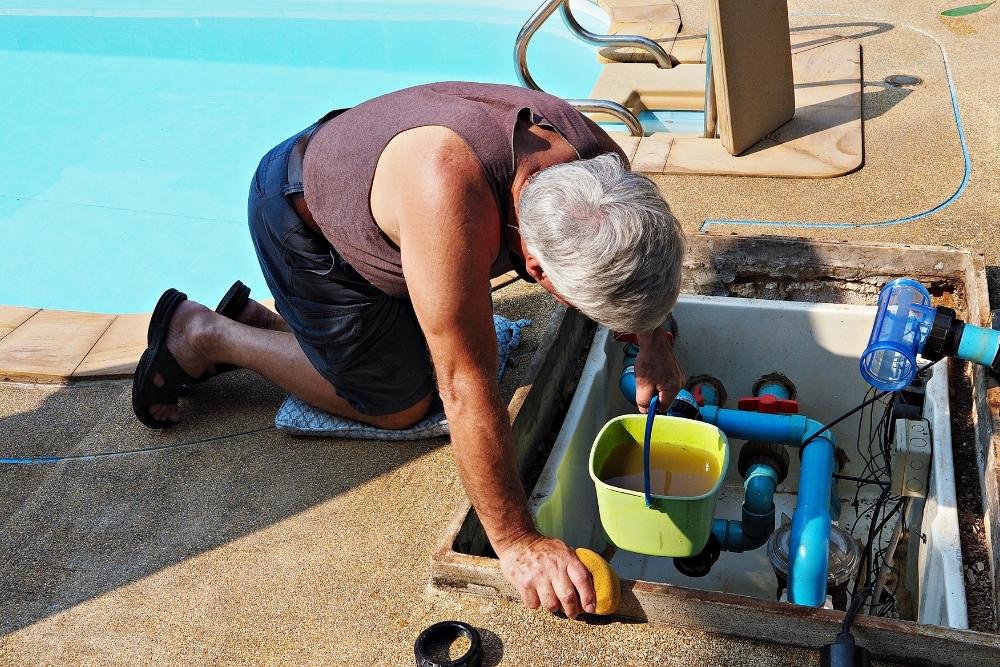Ever found yourself on the receiving end of a trickle instead of a stream from your tap, or wincing at the sight and smell of discoloured water? Yep, we’ve seen it all too. After doing our fair dinkum share of research, it turns out that giving our hot water system a regular flush was just what the doctor ordered to sort these issues out.
Not only did it clear up the problems but increased efficiency to boot. We’ve whipped up this detailed guide that’s chock-a-block with easy DIY steps so you can give your hot water heater a good ol’ flush and keep it humming along nicely.
Key Takeaways
- Flushing your hot water system can improve water pressure, remove sediment buildup, and increase efficiency.
- Signs that your hot water heater may need flushing include low water pressure, discoloured or smelly water, strange noises coming from the heater, and decreased heating efficiency.
- Before flushing your hot water system, remember to turn off the water heater and cold water supply, allow the water to cool down, locate the drain valve connect a hose for draining, and open a hot water faucet to relieve pressure.
- In addition to flushing, other maintenance tips for your hot water system include regularly checking the TPR valve for proper functioning, inspecting the anode rod for corrosion signs, and adjusting temperature settings for optimal efficiency.

Signs Your Hot Water Heater Needs Flushing
If you notice low water pressure, discoloured or smelly water, strange noises coming from your heater, or if it’s not heating up as quickly or efficiently, these are signs that your hot water heater may need flushing.
Low water pressure
Low water pressure can be a tell-tale sign that your hot water system needs flushing. Sediment build-up inside the heater impairs its functioning, resulting in decreased water flow through your fixtures.
This can lead to increased energy bills as the heater has to work harder to warm up your water supply. Regularly flushing out this sediment not only restores proper water pressure but also boosts your system’s efficiency and prolongs its lifespan.
Discolored or smelly water
If you notice that the water from your hot water system is discoloured or has an unpleasant odour, it may be a sign that your system needs flushing. This discolouration and smell can be caused by sediment buildup or bacteria growth in the tank.
Flushing your hot water heater will help remove these impurities and improve the quality of your water. Regular maintenance, including flushing, is important to keep your hot water system running efficiently and prevent any potential damage.
Strange noises coming from your heater
If you notice strange noises coming from your heater, it could be a sign that it needs flushing. Sediment buildup in the tank can cause this issue, leading to rumbling or banging sounds.
Flushing your water heater annually can help remove the sediment and improve its performance. By following the proper steps and safety precautions, you can easily flush your hot water system and prevent further damage or inefficiency.
The heater not heating up as quickly or efficiently
If your hot water heater is not heating up as quickly or efficiently as it used to, there may be some underlying issues that need to be addressed. Sediment buildup in the tank can cause a decrease in efficiency, making it take longer for the water to heat up.
Flushing your water heater annually can help remove this sediment and improve its performance. In addition, checking the temperature setting on your heater and insulating the pipes can also help increase efficiency.
Regular maintenance is key to ensuring that your hot water system functions optimally and lasts longer.
Safety Precautions Before Flushing
Before you begin flushing your hot water system, it’s important to take a few safety precautions to ensure everything goes smoothly.
Turn off the water heater and cold water supply
To begin flushing your hot water system, the first step is to turn off the water heater and cold water supply. This will ensure that no more hot or cold water enters the tank during the flushing process.
By doing this, you’ll prevent any accidental burns from hot water and avoid any potential damage to your system. Once you’ve turned off both valves, it’s important to allow the water inside the tank to cool down before proceeding with flushing.
This will help ensure a safe and effective flushing process without any risk of scalding yourself or damaging the components of your hot water system.
Allow the water to cool
After turning off the water heater and cold water supply, it is essential to allow the water inside the tank to cool before proceeding with the flushing process. This step is crucial for safety reasons and prevents any potential risks of burns or accidents during maintenance.
Waiting for the water to cool down also ensures that you can handle the drain valve and connect a hose without any concerns. Taking this precautionary measure allows you to proceed with confidence and carry out successful flushing of your hot water system.
Locate the drain valve and connect a hose
To start flushing your hot water system, find the drain valve on your water heater. It’s usually located at the bottom of the tank. Once you’ve located it, connect a garden hose to the valve.
This will allow you to easily direct and control where the water goes during the flushing process. Make sure to securely attach the hose before moving on to the next step.
Turn on a hot water faucet
To ensure a smooth flushing process, don’t forget to turn on a hot water faucet. This will help relieve pressure in the system and allow the water heater tank to drain more easily.
By opening a hot water faucet, you create a path for air to enter the system, which helps facilitate the draining process. Just remember to keep the faucet open until all the water has drained completely from your water heater.
This simple step will make flushing your hot water system more effective and efficient.
Steps to Flush Your Water Heater
To flush your water heater and improve its efficiency, follow these simple steps:
First, make sure to turn off the water heater and the cold water supply. This will prevent any accidents or damage while you are flushing the system.
Next, allow the water in the heater to cool down completely before proceeding with the flushing process. This will ensure your safety and avoid any burns from hot water.

Now, locate the drain valve on your water heater and connect a garden hose to it. Once connected, open the valve to start draining out the sediment-filled water from your tank.
While draining, it is recommended to open a hot water faucet in your home. This will help release any pressure in your system and allow for better flushing of sediment.
Finally, let all of the old water flow out through the garden hose until it runs clear. Once done, close both valves tightly and remove the hose.
By following these steps annually or as needed, you can effectively remove sediment buildup from your water heater and improve its performance and efficiency over time.
Other Ways to Maintain Your Hot Water System
Check the TPR valve regularly to ensure proper functioning, inspect the anode rod for signs of corrosion, and consider adjusting the temperature settings for optimal efficiency. By implementing these maintenance tips, you can extend the lifespan of your hot water system and enjoy consistent performance.
Checking the TPR valve
To ensure the safety and efficiency of your hot water system, it’s important to regularly check the Temperature Pressure Relief (TPR) valve. This valve is designed to release excess pressure if it builds up in the tank, preventing potential damage or even explosions.
Start by locating the TPR valve on the side or top of your water heater. Next, place a bucket under the discharge pipe connected to the valve. Gently lift and then lower the lever on the TPR valve to test its functionality.
If you observe any signs of leakage or if the lever doesn’t move freely, it may be necessary to replace the TPR valve. Remember that this is a job best left to professionals, so don’t hesitate to seek their help if needed.
Inspecting the anode rod
Inspecting the anode rod is an important part of maintaining your hot water system. The anode rod helps prevent corrosion inside the tank by attracting minerals and other corrosive elements.
To inspect the anode rod, start by turning off the power to the water heater and closing off its cold water supply. Locate the anode rod on top of the heater and unscrew it using a wrench or socket set.
Check for signs of rust, erosion, or significant wear on the rod’s surface. If you notice any damage or if more than 50% of the core wire is exposed, it’s time to replace it with a new one.

Adjusting the temperature
To improve the efficiency of your hot water system, adjusting the temperature is a simple but effective step. By reducing the temperature setting on your water heater, you can save energy and lower utility bills.
Most manufacturers recommend a temperature between 120 to 140 degrees Fahrenheit (49-60 degrees Celsius) for optimal performance. Lowering the temperature not only saves energy but also helps prevent scalding accidents, especially in households with young children or older adults.
With a few adjustments to the thermostat, you can enjoy hot water while being mindful of both safety and efficiency.
By adjusting the temperature settings on your hot water system, you can enjoy efficient and safe operation while reducing energy consumption. It’s important to find a balance between comfort and savings by experimenting with different temperatures until you find what works best for your household.
Regular maintenance like this keeps your hot water system running smoothly, prolongs its lifespan, and benefits both your wallet and the environment.
Hot Water Hassles? We’ve Got You Covered!
Regular flushing and maintenance can significantly improve the efficiency of your hot water system and extend its lifespan. By following these DIY tips, such as turning off the water heater, allowing it to cool, connecting a hose to the drain valve, and opening the cold water valve while flushing, you can remove sediment buildup and enhance performance.
Don’t forget to prioritise safety precautions and seek professional assistance if necessary for optimal results.
Ready to enhance the efficiency of your hot water system on your own terms? Hot Water Repairs Today is here with DIY tips for hot water system flushing. Don’t let sediment buildup compromise your system’s performance – take action now. Contact us for expert insights on DIY flushing techniques that can improve efficiency and extend the life of your hot water system. Trust Hot Water Repairs Today to be your guide in maintaining a reliable and efficient hot water supply. Don’t wait for reduced efficiency to impact your daily life – reach out now and discover the DIY tips that keep your system running smoothly. Act today for a hot water system that meets your needs reliably. Contact us now!






